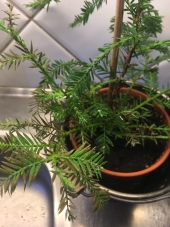




















Mark Vander Meer wrote:Redwoods need fog to really grow to their potential.




 1
1




A human being should be able to change a diaper, plan an invasion, butcher a hog, conn a ship, design a building, write a sonnet, balance accounts, build a wall, set a bone, comfort the dying, take orders, give orders, cooperate, act alone, solve equations, analyze a new problem, pitch manure, program a computer, cook a tasty meal, fight efficiently, die gallantly. Specialization is for insects.
-Robert A. Heinlein




yukkuri kame wrote:Was just out trimming some suckers off a redwood in my mum's place in the foothills north of L.A. The needles and branches are strongly acid, so consider that in your equation. Nothing is growing under the redwood. The redwood forests, as mentioned above, contain only a very few species, relative to most other forests.




 1
1













|
Life just hasn't been the same since the volcano erupted and now the air is full of tiny ads.
The new purple deck of permaculture playing cards
https://www.kickstarter.com/projects/paulwheaton/garden-cards
|





